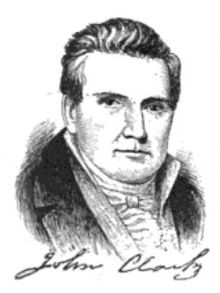John Clark (Georgia governor)
This article includes a list of general references, but it remains largely unverified because it lacks sufficient corresponding inline citations. (July 2011) |
John Clark | |
|---|---|
 | |
| Born | February 28, 1766 |
| Died | October 12, 1832 (aged 66) |
| Occupation | Planter, politician |
| Relatives | Elijah Clarke (father), Edward Clark (nephew) |
John Clark (sometimes spelled Clarke) (February 28, 1766 – October 12, 1832) was an American planter and politician.
Early life[]
Clark was born in 1766 in Edgecombe County, North Carolina. Along with his father, Elijah Clarke, Clark fought in the American Revolutionary War at the Battle of Kettle Creek and served in the Georgia militia.
He moved to Wilkes County, Georgia, in the early 1770s. He became a major general in 1796.
Political career[]

Clark served in the Georgia House of Representatives before he was elected to consecutive two-year terms as the 31st Governor, from 1819 to 1823. During his term, he successfully defended states' rights in a US Supreme Court case, Ex parte Madrazzo, over a Spanish citizen who claimed that he owned some of Clark's slaves.
Personal life[]
Clark resided at Woodville, a plantation in Milledgeville, Georgia.[1] He was married to Nancy Clark.
Death and legacy[]
Clark died of yellow fever in St. Andrews Bay (Florida) in 1832 in what was then Washington County (now Bay County) and was buried in that same city; however, his grave was relocated to Marietta National Cemetery in Georgia in 1923 by the Daughters of the American Revolution.
Clarkesville, Georgia[2] and Clarke County, Alabama are named after him.[3]
References[]
- ^ "National Register of Historic Places Inventory--Nomination Form: Westover, or Clark-Bentley House". National Park Service. Retrieved January 7, 2016.
- ^ "Clarkesville". Explore Georgia. Retrieved 28 November 2018.
- ^ "Clarke County: A Brief History". Clarke County Historical Museum. Retrieved 3 January 2009.
Sources[]
- "John Clark (1766-1832)," New Georgia Encyclopedia.
- Georgia State Archives Roster of State Governors
- Georgia Governor's Gravesites Field Guide (1776-2003)
- Georgia Secretary of State official website
- John Clark House historical marker
External links[]
- Troup-Clarke Political Feud historical marker
- 1766 births
- 1832 deaths
- People from Edgecombe County, North Carolina
- Governors of Georgia (U.S. state)
- Members of the Georgia House of Representatives
- Georgia (U.S. state) militiamen in the American Revolution
- Deaths from yellow fever
- People of Georgia (U.S. state) in the American Revolution
- Infectious disease deaths in Florida
- Burials in Georgia (U.S. state)
- Georgia (U.S. state) Democratic-Republicans
- Democratic-Republican Party state governors of the United States
- American planters
- American slave owners
- American duellists
